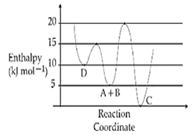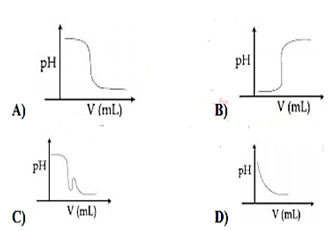 Multiple Choice Questions
Multiple Choice QuestionsWhat would be the molality of 20% (mass / mass) aqueous solution of KI? (molar mass of KI = 166 g mol-1)
1.08
1.35
1.51
1.48
HF has highest boiling point among hydrogen halides, because it has:
Strongest van der Waal’s interactions
Lowest ionic character
Strongest hydrogen bonding
Lowest dissociation enthalpy
At a given temperature T, gases Ne, Ar, Xe and Kr are found to deviate from ideal gas behaviour. Their equation of state is given as p = at T. Here, b is the van der Waals constant. Which gas will exhibit steepest increase in the plot of Z (compression factor) vs p?
Ne
Xe
Ar
Kr
During compression of a spring the work done is 10 kJ and 2 kJ escaped to the surroundings as heat. The change in internal energy, U (in kJ) is:
-12
8
12
-8
Which one of the following about an electron occupying the 1s orbital in a hydrogen atom is incorrect? (The Bohr radius is represented by a0).
The electron can be found at a distance 2a0 from the nucleus.
The probability density of finding the electron is maximum at the nucleus.
The total energy of the electron is maximum when it is at a distance a0 from the nucleus.
The magnitude of the potential energy is double that of its kinetic energy on a an average.
Consider the given plot of enthalpy of the following reaction between A and B. A + B → C + D. Identify the incorrect statement.

C is the thermodynamically stable product.
Formation of A and B from C has highest enthalpy of activation.
Activation enthalpy to form C is 5 kJ mol-1 less than that to form D.
D is kinetically stable product.
The correct statement among I to III are:
(I) Valence bond theory cannot explain the color exhibited by transition metal complexes.
(II) Valence bond theory can predict quantitatively the magnetic properties of transition metal complexes.
(III) Valence bond theory cannot distinguish ligands as weak and strong field ones.
(I) and (III) only
(II) and (III) only
(I), (II) and (III)
(I) and (II) only
In an acid-base titration, 0.1 M HCl solution was added to the NaOH solution of unknown strength. Which of the following correctly shows the change of pH of the titration mixture in this experiment ?

(D)
(A)
(C)
(B)